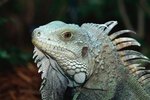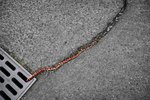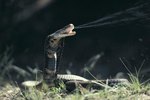
Snakes arose from within a group of lizards; therefore, to an evolutionary biologist, snakes are lizards. Despite a few derived traits that only snakes have, they share many characteristics with some lizards. Both groups feature ectothermic metabolisms and most reproduce in similar manners. They share other behavioral adaptations. Some lizards have even lost their legs, further demonstrating the similarities between the two groups.
Losing My Appendages
In addition to a few other evolutionary adaptations, all snakes have lost their front legs; advanced snakes have lost their rear legs as well, though many primitive snakes retain vestigial rear legs. The same trend occurs in a number of lizard lineages: Some lizards have greatly reduced legs, while others have lost their legs entirely.
Compatible Copulatory Components
Male snakes and male lizards possess paired copulatory organs, known as hemipenes. They carry the hemipenes internally, inverted inside the bases of their tails. Males breed by first everting one of their hemipenes and then inserting it into the female’s cloaca. Both groups exhibit a variety of reproductive methods; most produce eggs, but several species of both groups produce live young.
Personal Protection
Just as is the case with lizards, snakes exhibit numerous defensive behaviors and strategies. A handful of behaviors are widespread in both groups. Fast lizards, including whiptails (Cnemidophorus sp.) and skinks (Eumeces sp.), use locomotor tactics to escape predators, just as fast snakes such as racers (Coluber ssp.) and whipsnakes (Masticophis ssp.) rely on their speed to defend themselves. Additionally, monitor lizards (Varanus ssp.), bearded dragons (Pogona vitticeps) and frilled dragons (Chlamydosaurus kingii) inflate their necks or erect frills to make their heads look bigger -- seeking to accomplish the same goal that cobras (Naja ssp.) and hognose snakes (Heterodon platirhinos) do.
Breaking Bread
While each group contains thousands of species, and broad generalities are elusive, many lizards and snakes subsist on similar food. Insect- and invertebrate-eating lizards abound in nature; while insectivorous snakes are not common, rough green snakes (Oephydras aestivus) and smooth green snakes (Opheodrys vernalis) subsist on insects. Many other snake species hunt other invertebrates, including slugs, snails, crayfish and worms. Large snake species often hunt rodents, lizards and birds, just as large monitor lizards and tegus (Tupinambis ssp.) do. Egg-eating species populate both lineages as well, including the venomous gila monster (Heleoderma suspectum) as well as African egg-eating snakes (Dasypeltis ssp.)
Skin-Deep Similarities
While the scales of snakes and lizards are essentially similar, great variation exists between the various species; lizards exhibit many scale types and patterns not seen in snakes. While no snake has scales as fine as a gecko’s or the incredible color-changing capabilities of chameleons, both groups have developed several similar scale types. Iridescent scales cover rainbow boas (Epicrates cenchria ssp.) and short-tailed lizards (Lygosoma veusaiensis); while rattlesnakes (Crotalus ssp.) and fence lizards (Sceloporus ssp.) have rough, keeled scales. Both snakes and lizards shed their skin periodically, though many lizards tend to shed continuously and while snakes shed at discrete times.
References
- Evolution: How Lizards Turn Into Snakes: A Phylogenetic Analysis of Body-Form Evolution in Anguid Lizards
- Conservation International: New Species: Iridescent Short-Legged Lizard Discovered in Northeast Cambodia
- Smithsonian National Zoological Park: Brazilian Rainbow Boa
- University of Colorado Museum of Natural History: Hemipenes of Snakes and Lizards
- Animal Diversity Web: Chlamydosaurus Kingii
- Animal Diversity Web: Varanus Gouldii
- Savannah River Ecology Laboratory: Rough Green Snake (Opheodrys Aestivus)
- IUCN Redlist: Dasypeltis Fasciata
- Biology Letters: Resolving the Phylogeny of Lizards and Snakes (Squamata) With Extensive Sampling of Genes and Species
Photo Credits
-
Jupiterimages/Photos.com/Getty Images




